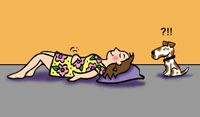 Good form is important to remember when working out. When performing any exercise, you want to make sure that your form is correct and your movements are controlled. Learning how to ‘lock it up’ helps to make your workouts more effective, and maybe more importantly for others, it helps to keep you from being all willy-nilly looking when exercising!
Good form is important to remember when working out. When performing any exercise, you want to make sure that your form is correct and your movements are controlled. Learning how to ‘lock it up’ helps to make your workouts more effective, and maybe more importantly for others, it helps to keep you from being all willy-nilly looking when exercising!
Proper form is maintained by doing this: contracting your shoulder blades together while pressing down your shoulders. (In personal trainer speak, your shoulders areretracted and depressed.) This helps to tighten your upper body so when you perform an exercise, you will be able to maintain balance and control, thus preventing a possible injury or fall. (Forget about the potential dumbbell that could come crashing down on your big toe followed by insane amounts of pain, screaming and crying, and not to mention the utter embarrassment that will surely ensue, but just imagine the unsightly flash of skin that could come flouncing out of your t-shirt or tank top as you roll across the floor in agony. Images like these must be avoided at all costs so learn good form! Yeeees, I may be talking from experience.)
Now while you’re standing tall, pressing your shoulders down and back, you also want to be holding in your belly. Imagine drawing your bellybutton into your spine, while maintaining neutral spine (meaning you want to keep that small curve in your lower back.) So your upper back, shoulders, abs and lower back are all contacting and holding your position. From there you are ready to perform your exercises. (Sounds like you’re locked up in a straight-jacket, I know.)
However, if I may push my luck and assume you’re still reading this, before you flock to the gym floor to get your fitness with your form on, there is one more thing you need to remember. Your breathing. The best way I’ve learned to explain this is to tell my clients to exhale when they are performing a move that goes against gravity. Let’s say you’re performing a bicep curl, you will exhale when you are bringing the weight up to your shoulder, and then inhale when you are lowering the weight back down. Or if you’re performing a lunge, when you step your foot forward, you inhale, and then as you push through the front leg back to standing position, you exhale.
Exhaling usually allows for a quicker, faster move while inhaling allows for you to draw the motion out. For example, back to the bicep curl, when you’re lifting the weight, you would exhale to a count of 2. Then when you’re lowering the weight, draw it out to a count of 4. This way you’re working your muscles concentrically and eccentrically. (I totally just geeked out there and went so far as to use technical terms. I must apologize… I feel like I should say something witty and entertaining to make up for it but I’m still in geek mode.) When you draw out the breath to a count of 4, you’re working the opposing muscles so you’re getting a better workout and will probably fatigue the muscle faster depending on the amount of poundage you’re lifting and the number of reps.
So there it is, in true fitness geek-speak. Lock it all up, maintain good form throughout, don’t forget to breath, and do your counting (2 for exhale, 4 for inhale.)







